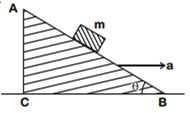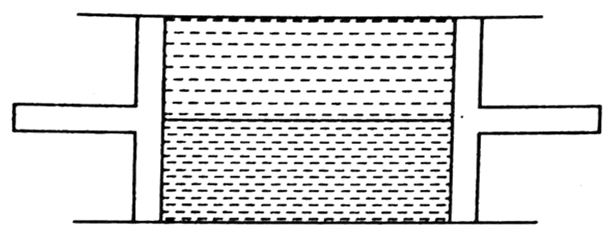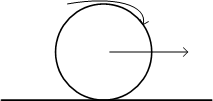 Multiple Choice Questions
Multiple Choice QuestionsWhich one of the following statements is incorrect?
Rolling friction is smaller than sliding friction.
Limiting value of static friction is directly proportional to normal reaction.
Coefficient of sliding friction has dimensions of length.
Frictional force opposes the relative motion.
A moving block having mass m, collides with another stationary block having mass 4m. The lighter block comes to rest after collision. When the initial velocity of the lighter block is v, then the value of coefficient of restitution (e) will be
0.5
0.25
0.4
0.8
A block of mass m is placed on a smooth inclined wedge ABC of inclination θ as shown in the figure. The wedge is given an acceleration 'a' towards the right. The relation between a and θ for the block to remain stationary on the wedge is

![]()
![]()
a = g tan θ
a = g cos θ
A cylindrical tube of uniform cross-sectional area A is fitted with two air tight frictionless pistons. The pistons are connected to each other by a metallic wire. Initially, the pressure of the gas is p0 and temperature is T0, atmospheric pressure is also p0. Now, the temperature of the gas is increased to 2T0, the tension of the wire will be

2p0A
p0A
p0A/2
4p0A
A skier starts from rest at point A and slides down the hill without turning or breaking. The friction coefficient is μ. When he stops at point B, his horizontal displacement is S. what is the height difference between points A and B?
(The velocity of the skier is small so that the additional pressure on the snow due to the curvature can be neglected. Neglect also the friction of air and the dependence of μ on the velocity of the skier.)
h = μS
h = μ/S
h = 2μS
h = μS2
A bicycle wheel rolls without slipping on the horizontal floor. Which one of the following is true about the motion of points on the rim of the wheel, relative to the axis at the wheel's centre?

Points near the top move faster than points near the bottom
Points near the bottom move faster than points near the top
All points on the rim move with the same speed
All points have the velocity vectors that are pointing in the radial direction towards the centre of the wheel
The upper half of an inclined plane of inclination θ is perfectly smooth while the lower half rough. A block starting from rest at the top of the plane will again come to rest at the bottom if the coefficient of friction between the block and the lower half of the plane is given by
μ = 2 tanθ
μ = tanθ
μ = 2/(tan θ)
μ = 1/ tan θ
Two masses 10 kg and 20 kg respectively are connected by a massless springs as shown in the figure. A force of 200 N acts on the 20 kg mass. At the instant shown is a figure the 10 kg mass has an acceleration of 12 m/s2. The value of the acceleration of 20 kg mass is

4 m/s2
10 m/s2
20 m/s2
30 m/s2
A cylinder rolls up an inclined plane, reaches some height and then rolls down (without slipping throuhgout these motions). The directions of the frictional force acting on the cylinder are
Up the incline, while ascending and down the incline while descending
Up the incline, while ascending as well as descending
down the incline, while ascending and up the incline while descending
Down the incline while ascending as well as descending.
A long block A of mass M is at rest on a smooth horizontal surface. A small block B of mass M/2 is placed on A at one end and projected along A with same velocity v. The coefficient of friction between the block is μ. Then the acceleration of blocks A and B before reaching a common velocity will be respectively

